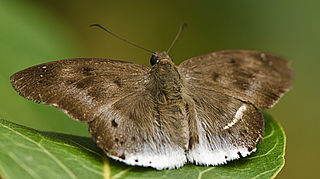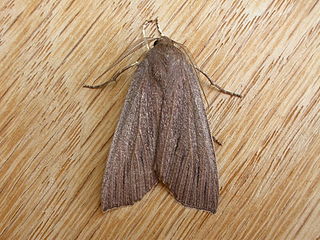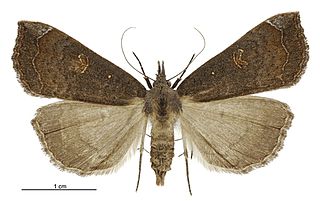
Tagiades japetus, commonly known as the pied flat or the common snow flat, is a species of spread-winged skipper butterfly belonging to the family Hesperiidae. It is widely distributed, being found from India, the Himalayas, Southeast Asia, to Australia. It contains twenty-four recognized subspecies.

Spilomelinae is a very species-rich subfamily of the lepidopteran family Crambidae, the crambid snout moths. With 4,132 described species in 340 genera worldwide, it is the most speciose group among pyraloids.

Cydalima is a genus of moths of the Crambidae: Spilomelinae subfamily.
Argidava is a genus of moths in the family Geometridae erected by Francis Walker in 1863.

Didymoctenia is a monotypic moth genus in the family Geometridae and subfamily Ennominae which was described by Warren in 1901. Its only species, Didymoctenia exsuperata, the thick-lined bark moth, was first described by Francis Walker in 1860. It is found in Australia.

Palleopa is a monotypic moth genus in the family Geometridae. Its only species, Palleopa innotata, the finely-streaked crest-moth, is known from Australia, including Tasmania. Both the genus and species were first described by Francis Walker in 1866.

Eudocima materna, the dot-underwing moth, is a moth of the family Erebidae found in widespread parts of the world, mainly in tropical Asia extending to New Guinea and Australia as well as in Africa. Reports from the United States, Canada and the French Antilles are now considered to be Eudocima apta. The species can be differentiated from other Eudocima moths by the presence of small central black dot in each hindwing. The species was first described by Carl Linnaeus in his 1767 12th edition of Systema Naturae.
Heterocrossa contactella is a species of moth in the family Carposinidae. It is endemic to New Zealand.

Cydalima perspectalis or the box tree moth is a species of moth of the family Crambidae, first described by Francis Walker, the English entomologist, in 1859. Native to Japan, China, Taiwan, Korea, far-east Russia and India, it has invaded Europe; first recorded in Germany in 2006, then Switzerland and the Netherlands in 2007, Great Britain in 2008, France and Austria in 2009, Hungary in 2011, then Romania, Spain and Turkey. It is been seen in Slovakia, Belgium and Croatia,

Rhapsa scotosialis, the slender owlet moth, is a moth of the family Noctuidae. R. scotosialis is one of the most common forest moths found in New Zealand.

Hypena conscitalis is a moth of the family Erebidae first described by Francis Walker in 1866. It is found throughout Africa, from Senegal to South Africa, in South and South-East Asia as well as in Australia and on some Pacific and Indian Ocean islands.
Strepsicrates semicanella is a species of moth of the family Tortricidae first described by Francis Walker in 1866. It is found in south-east Asia and in New Caledonia, Australia and Japan. The habitat consists of alluvial forests.
Conogethes ersealis is a moth in the family Crambidae. It was described by Francis Walker in 1859. It is found in Australia, where it has been recorded from Queensland.

Cydalima laticostalis is a moth in the family Crambidae. It was described by Achille Guenée in 1854. It is found from India, Sri Lanka, Burma and Malaysia to the New Hebrides. It is also found in Australia, where it has been recorded from tropical Queensland.

Cydalima pfeifferae is a moth in the family Crambidae. It was described by Julius Lederer in 1863. It is found in India, Myanmar, Singapore, Indonesia, Taiwan and Australia, where it has been recorded on Queensland.
Orphnophanes eucerusalis is a moth in the family Crambidae. It was described by Francis Walker in 1859. It is found in Indonesia, India (Sikkim) and Australia, where it has been recorded from Queensland.
Dichomeris georgiella is a moth in the family Gelechiidae. It was described by Francis Walker in 1866. It is found in North America, where it has been recorded from south-eastern Canada and Maine, south to Florida, west to Texas, Oklahoma and Illinois. It has also been recorded from Colorado and Arizona.
Cryptophasa balteata is a moth in the family Xyloryctidae. It was described by Francis Walker in 1866. It is found in Australia, where it has been recorded from New South Wales, Queensland and South Australia.
Xylorycta viduata is a moth in the family Xyloryctidae. It was described by Francis Walker in 1869. It is found in Australia, where it has been recorded from the Australian Capital Territory and Victoria.
Agriophara atratella is a moth in the family Depressariidae. It was described by Francis Walker in 1866. It is found in Australia, where it has been recorded from Queensland and New South Wales.









